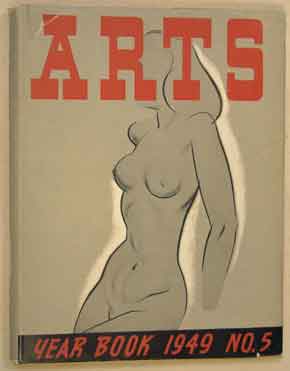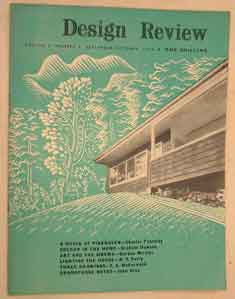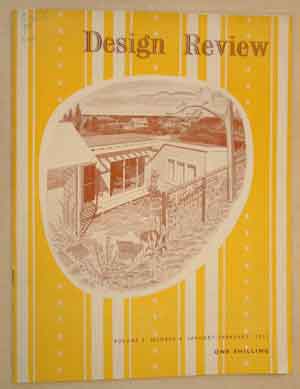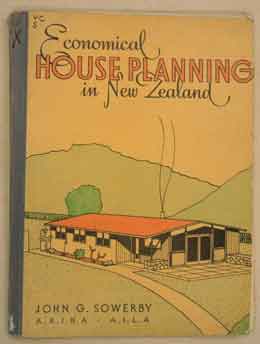
The Word on Modernism:
How books aided a revolution in design, 1925-1965
| Introduction |
| Architectural Review |
| Le Corbusier |
| European Tradition |
| American Tradition |
| English Tradition |
| New Zealand - Beginnings |
| Walls |
| Curator |
New Zealand - The Beginnings
|
No image available |
Cyril Knight (1909–1989) was the first professor at the Auckland School of Architecture. An Australian trained under the Beaux-Arts system, he was not an easy convert to the new style of modernist architecture. His 1930 lecture reproduced here concerned the search for a fitting style of architecture for the technological age and uses R. A. Lippincott’s (1885–1969) recently built Auckland University College’s Arts Building for the cover illustration. ___________________________________________________________ |
|
No image available
|
The New Zealand writer Alan Mulgan was asked to edit this small book on the role of the architect by the New Zealand Institute of Architects. Eschewing all forms of modernism, the book seeks to reassure potential clients that an architectural plan will be both functional and money saving. ___________________________________________________________ |
|
No image available
|
The Home Science Department of Otago University taught the basics of domestic architectural design with a concentration on planning and interior decorating. This Bulletin includes the modern kitchen designed by students and exhibited at the 1925-25 New Zealand and South Seas Exhibition. ___________________________________________________________ |
|
No image available
|
The New Zealand journal Home and Building began in 1936 under the title Building Today. With its stylish cover designs by Eric Tice-Martin and coverage of diverse architectural styles, Home and Building reflected the broad range of opinion on modern architecture during the 1930s ___________________________________________________________ |
|
View large (100 Kb)
|
The Year Book of the Arts was a project of the Wellington publisher Harry Tombs (1874–1966) who saw room for an annual survey of literature and visual arts including architecture. The houses in this issue were selected by T. J. Haiselden with Vernon Brown (1905–1965) and Paul Pascoe (1908–1976); two architects who did a great deal to publicise modernism through both words and deeds. Pascoe had worked in Britain with Berthold Lubetkin and Tecton during the late 1930s while Brown was amalgamating Scandinavian and American modernism into a new New Zealand vernacular. ___________________________________________________________
|
|
No image available
|
Landfall was a literary journal established by the Dunedin writer Charles Brasch (1909–1973). Its second issue in June 1947 contained an article by Christchurch architects Paul Pascoe and Humphrey Hall (1912–1988) on The Modern House, using Hall’s own 1938 house in Timaru as an example of what might be done with the new style. ___________________________________________________________ |
|
No image available
|
Ernst Plischke (1903–1992) was one of a small number of emigré architects who left the perilous pre-war situation in Europe for New Zealand. He worked in the Housing Department until 1947 but found many restrictions in his way. The Henderson house in Alexandra with its strong mix of local stone and modernist forms showed Plischke grappling with the regional identity problem of the New Zealand modern house. The book On the Human Aspect in Modern Architecture was a survey of Plischke’s work in both Europe and New Zealand ___________________________________________________________ |
|
No image available
|
Plischke’s immediate contemporary, the Hungarian Marcel Breuer, found himself in Britain before the war in partnership with F. R. S. Yorke. While there, Bruer designed a pavilion for the furniture maker P. E. Gane, Ltd for the 1936 Royal Show in Bristol. Gane’s pavilion showed a way forward for modernism by using the warm local stone of the region in a non-traditional way. This catalogue was produced for the exhibition Modern Architecture In England held at New York’s Museum of Modern Art in 1937. ___________________________________________________________ |
|
View large (169 Kb)
View large (169 Kb)
|
Design Review was produced between 1948 and 1954 by the Wellington-based Architecture Centre, which was set up in 1946. Its editorial group included Ernst Plischke and artist and engraver E. Mervyn Taylor whose graphic design greatly enlivened the journal. The Design Review was the main competitor for Home and Building during the early 1950s. ___________________________________________________________ |
|
No image available
|
Renowned architectural historian and critic Nikolaus Pevsner summarized the issues for ‘colonial’ architects in the introduction to New Buildings in the Commonwealth when he wrote ‘Their roots are in Britain, but their eyes are on the United States.’ Hesitant to commit to the idea that a native style was arising from this mix of influences, he was only prepared to offer Ernst Plischke as an architect of international standing. ___________________________________________________________ |
|
No image available
|
By the late 1950s, the influence of modernist architecture was reaching the wider building community. Builders’ plan books included designs using the ‘open plan’, low sweeping rooflines, contrasting materials and broad expanses of glass. Architect’s houses were becoming difficult to distinguish from their builder’s counterparts. ___________________________________________________________ |
|
View large (145 Kb)
|
A. H. & A. W. Reed published Economical House Planning in New Zealand as a simple guide to planning a home under the restrictive codes put in place after the war. Limitations on materials meant that houses were considerably smaller than today and ingenuity was required to squeeze all of the functions of a family home into a small space. ___________________________________________________________ |
|
No image available
|
The new architectural journal Building Today set out the modernist dilemma with the article ‘Evolution or Revolution; What New Zealand Architects are doing with Modernism’. The turning point in the development of modernism in New Zealand was 1936 and it seemed that the new style could not be held off any longer. The example used in the article, however, is British modernist E. Maxwell Fry’s (1899–1987) ‘Sun House’ in the London suburb of Hampstead. ___________________________________________________________ |
|
No image available
|
The New Zealand centennial publication Making New Zealand: Pictorial Surveys of a Century built up into an impressive set of volumes outlining the history of the country to that point. Its section on houses was written by Christchurch architect Paul Pascoe who included his own design for the Dunedin house of W. John Harris (1903-1980), the University of Otago Librarian (line drawing, right page). ___________________________________________________________ |
|
No image available
|
The Demonstration House was designed by students of Wellington’s Architecture Centre. Constructed on an almost impossible site in Karori, it was opened to the public in October 1949. The Architecture Centre’s programme was highly ambitious. It published the magazine Design Review as well as organizing design related exhibitions and events. The Demonstration House was sold and the funds assisted the establishment of the School of Architecture and Town Planning at Victoria University, New Zealand’s second architectural school after Auckland's. ___________________________________________________________ |
|
No image available
|
Planning 1 was the magazine of the Auckland-based Architectural Group. Formed at the School of Architecture in 1946, the Group approached architecture as a mission to reform the stale practices and attitudes of the pre-war era. Planning 1 was accompanied by a manifesto setting out the Group’s radical aims. It included essays by poet A. R. D. Fairburn, Ernst Plischke, and architect and teacher Vernon Brown. ___________________________________________________________ |
|
No image available
|
Students of architecture at Auckland University curated an exhibition surveying New Zealand building between 1350 and 1954. Early colonial building was praised for its utility and simple style while the state house was criticized for its standardization and monotony. Architecture was safe in the hands of ‘The New Pioneers’ who would ensure that modern architecture would restore ‘the dignity of human relationships.’ ___________________________________________________________ |
|
No image available
|
At Home: A Century of New Zealand Design summarizes the modernist era described in this exhibition. Using many of the books and journals also found in the Otago University Library, Auckland design historian Douglas Lloyd-Jenkins concentrates on the history of popular modern design in the middle class home. The cover image features a home in epitome of 1960s modern style; open, woody, and freely planned. ___________________________________________________________
|
|
No image available
|
Looking for the Local is based on research into modern New Zealand architecture carried out by the Architecture Centre in the 1950s for a book that did not appear. Reassembled by Justine Clark and Paul Walker, the book investigates the way that images of building affected understanding of architecture and particularly modernism. ___________________________________________________________ |
|
No image available
|
Wellington architect Bill Toomath’s 1949 house for his parents in Lower Hutt was widely reported in New Zealand and inter-nationally. Built in timber, the Toomath Sr. house became part of a vigorous debate about the nature of New Zealand modernism. Historian Nikolaus Pevsner judged the detailing of New Zealand modern building to be crude while younger architects such as Toomath claimed that robustness suited the local character. ___________________________________________________________ |
|
No image available
|
‘Streamline Modern’, ‘Spanish Bungalow’, ‘Georgian Cottage’. The diversity of the New Zealand suburb was reflected in the choices offered by publications such as the Building Progress No. 1 Plan Book, issued in the mid-1950s. Design from different eras co-existed and styles from the 1930s continued to be built long into the post-war period. ___________________________________________________________ |
|
No image available
|
Plischke wrote Design and Living in 1947, a revamped and expanded text of his writings which first appeared in the Army Education and Welfare Service bulletin About Houses in 1943. This work was his most influential. He wrote regularly for Design Review from 1948 to 1954 and taught town planning and architectural design at the Wellington Architectural Centre’s summer schools. ___________________________________________________________
|



